Philips Sterilizer Avent is trusted by parents worldwide to keep baby feeding essentials safe and hygienic. Keeping baby bottles, pacifiers, and breast pump parts germ-free is one of the most important steps in protecting your baby’s health. Since newborns have developing immune systems, even a small amount of bacteria or residue can lead to infections or stomach issues.
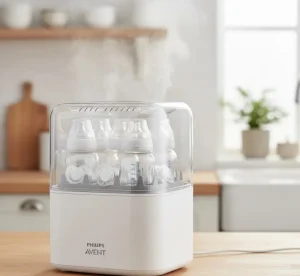
Moreover, Philips Avent is one of the most recognized names in baby care, known for its high safety standards, easy-to-use designs, and reliable sterilization technology. Whether you’re a first-time parent or upgrading your baby gear, the Philips Sterilizer Avent range offers multiple models to suit every lifestyle.
Why Choose Philips Avent Sterilizers
Philips Avent has been a market leader in baby feeding and sterilization products for over 30 years, consistently winning awards for quality and innovation. That’s why parents choose this brand over others:
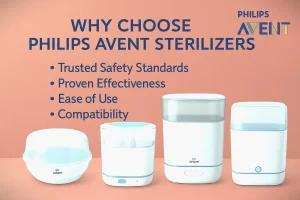
- Trusted Safety Standards: All Philips Avent sterilizers are BPA-free and use natural steam or UV light—no harmful chemicals.
- Proven Effectiveness: Each model kills 99.9% of harmful germs in just a few minutes.
- Ease of Use: Simple controls, automatic shutoff, and minimal maintenance make it perfect for busy parents.
- Compatibility: Works with a wide range of bottles, breast pump parts, and pacifiers—not just Philips products.
Visit our: Complete Guide to Infant Bottle Sterilizers
Types of Philips Avent Sterilizers
Philips offers a variety of sterilizers to fit different needs, from compact microwave units to advanced electric dryers. Below is a quick overview:
| Model | Best For | Cycle Time | Key Features |
| Microwave Steam Sterilizer | Travel & small kitchens | 2–4 mins | Lightweight, fast, budget-friendly |
| Electric 3-in-1 Steam Sterilizer | Everyday use | ~6 mins | Adjustable size, holds up to 6 bottles |
| Advanced Electric Sterilizer & Dryer | Busy parents | ~40 mins (with drying) | Drying function, 24-hour sterile storage |
| UV Sterilizer | Chemical-free sterilization | 10 mins | Uses UV light, no water required |
Philips Avent Microwave Steam Sterilizer
This is the most portable and budget-friendly model. Simply add water, load your bottles, and place it in the microwave. In just 2 minutes, you can sterilize up to 4 bottles. Therefore, it’s perfect for parents who travel or have limited counter space.
Philips Avent Electric 3-in-1 Sterilizer
A versatile option that allows you to adjust the size depending on what you’re sterilizing—bottles, breast pump parts, or small accessories. The cycle takes only about 6 minutes, and bottles remain sterile for up to 24 hours if the lid remains closed.
Philips Avent Advanced Electric Sterilizer & Dryer
This all-in-one machine not only sterilizes but also dries bottles completely, so you don’t need a separate drying rack. As a result, it’s ideal for parents who want to avoid moisture buildup or live in humid climates.
Philips Avent UV Sterilizer
Instead of steam, this model uses UV light to kill germs. Because no water is needed, it’s virtually maintenance-free. Additionally, it’s especially useful for sterilizing electronics or items that can’t be exposed to steam.
Key Features and Benefits
Philips Avent sterilizers share some standout features that set them apart from competitors:
- Large Capacity: Most models hold up to 6 bottles at a time, plus pacifiers and breast pump accessories.
- Fast Sterilization: Depending on the model, cycles range from 2–6 minutes (steam) to 10 minutes (UV).
- Automatic Shutoff: Built-in safety ensures the machine powers down after each cycle.
- 24-Hour Sterile Storage: Keep bottles sterile inside the closed unit for a full day.
- Energy Efficiency: Uses minimal water and electricity.
Step-by-Step: How to Use Philips Avent Sterilizers
Regardless of which model you choose, the process is simple and quick:
- Wash First—Clean bottles and accessories with warm, soapy water to remove milk residue.
- Add Water—For steam models, pour the recommended amount of distilled water into the base.
- Load Bottles—Place bottles upside down to ensure maximum steam penetration.
- Select Cycle – Press the power button or start your microwave timer.
- Cool & Store – Allow items to cool before removing them. Keep the lid closed to maintain sterility.
Pro Tip: Always use distilled or filtered water to avoid mineral buildup.
Maintenance & Cleaning Tips
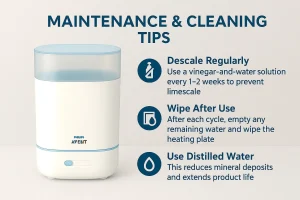
Keeping your Philips Avent sterilizer in top shape ensures long-lasting performance. Therefore:
- Descale Regularly—Use a vinegar-and-water solution every 1–2 weeks to prevent limescale.
- Wipe After Use – After each cycle, empty any remaining water and wipe the heating plate.
- Use Distilled Water—This reduces mineral deposits and extends product life.
Learn proper cleaning frequency: How often to Sterilize Baby Bottles
Top Philips Avent Models in 2025 – Mini Reviews
- Philips Avent Microwave Steam Sterilizer
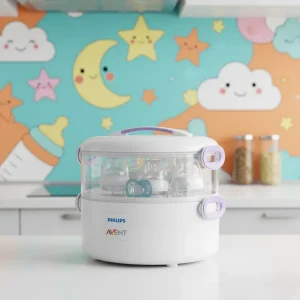
- Pros: Lightweight, fast (2–4 mins), budget-friendly.
- Cons: Requires microwave access.
Best For: Travelers and small kitchens.
2. Philips Avent Electric 3-in-1 Sterilizer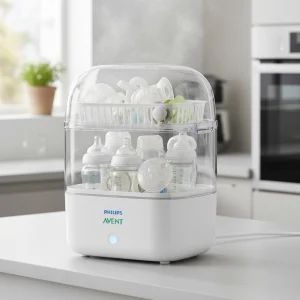
-
- Pros: Adjustable size, quick cycle (6 mins), easy storage.
- Cons: No drying function.
Best For: Daily use for newborn feeding needs.
3. Philips Avent Advanced Electric Sterilizer & Dryer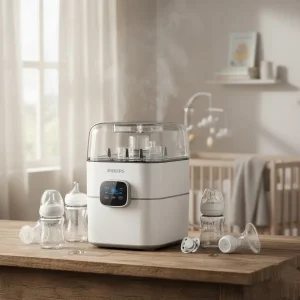
-
- Pros: Built-in drying, 24-hour sterile storage, spacious design.
- Cons: Higher price point.
Best For: Busy parents who want an all-in-one solution.
4. Philips Avent UV Sterilizer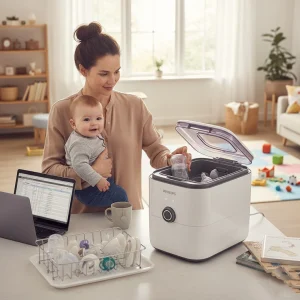
-
- Pros: No water or steam, chemical-free, versatile for electronics.
- Cons: Longer cycle compared to steam.
Best For: Parents seeking a low-maintenance, eco-friendly option.
Philips Avent Sterilizer vs. Competitors
When comparing baby bottle sterilizers, Philips Avent consistently stands out among top brands like Baby Brezza, Munchkin, and Dr. Brown’s. Here’s a quick breakdown:
| Feature | Philips Avent | Baby Brezza | Munchkin | Dr. Brown’s |
| Sterilization Method | Natural steam or UV light | Steam + dryer combo | Steam | Steam |
| Cycle Time | 2–6 minutes (steam) | 8 minutes (drying adds extra) | 6–8 minutes | 12 minutes |
| Bottle Compatibility | Wide & standard neck, most brands | Mostly wide neck | Limited | Limited |
| Safety Standards | BPA-free, automatic shutoff | BPA-free | BPA-free | BPA-free |
| Ease of Cleaning | Simple trays, minimal parts | Multiple detachable parts | Moderate | Moderate |
Why Philips Avent Wins
- Faster sterilization: Its steam models can complete a cycle in as little as 2 minutes, which is faster than most competitors.
- Universal compatibility: Works with all major bottle brands, not just Philips.
- Proven reliability: Over three decades of research and parent trust give Philips a track record few competitors can match.
- Variety of models: From microwave units to advanced UV sterilizers, parents can choose the technology that fits their lifestyle.
Expert & Parent Reviews
Pediatricians consistently recommend steam sterilization as one of the safest and most effective methods for killing harmful bacteria on baby feeding equipment.
For example, Dr. Emily Carter, MD, a board-certified pediatrician, says, “Steam sterilizers like Philips Avent provide a chemical-free way to destroy 99.9% of germs in just a few minutes—something boiling water alone cannot guarantee.”
Meanwhile, parents share positive feedback:
- Durability: Many parents report using the same unit for multiple children over several years without performance issues.
- Ease of Use: One-touch operation and automatic shutoff make it almost effortless.
- Value for Money: Even the advanced electric models are competitively priced compared to similar high-end sterilizers.
Sample customer reviews include:
- “The 3-in-1 electric sterilizer is a lifesaver during late-night feedings—fast, quiet, and easy to clean.”
- The UV model is perfect for our small apartment. No water, no mess, and my baby’s bottles stay sterile all day.”
Common Problems & Solutions
Even the most reliable sterilizer may experience minor issues over time. However, most can be fixed easily.
| Problem | Likely Cause | Quick Solution |
| Mineral Buildup | Using tap water instead of distilled water | Descale every 1–2 weeks using a 1:1 mix of white vinegar and water. Run a sterilization cycle without bottles, then rinse thoroughly. |
| Cloudy Bottles After Sterilization | Hard water deposits | Wash bottles thoroughly before sterilizing and switch to distilled or filtered water. |
| Cycle Won’t Start | Power cord or microwave issue | Check the plug and outlet or confirm wattage and timing per manual. |
| Lingering Odor | Residual milk or detergent | Deep clean the sterilizer with mild, fragrance-free soap and rinse well. |
Tips to Extend Product Lifespan
- Always empty the remaining water after each cycle to prevent residue buildup.
- Use distilled or filtered water to reduce scaling and improve performance.
- Store the sterilizer in a cool, dry place when not in use to prevent moisture damage. Ultimately, by following these maintenance steps, a Philips Avent sterilizer can easily last through multiple babies and years of daily use, making it a smart long-term investment for growing families.
FAQ
How long does the Philips Avent sterilizer keep bottles sterile?
Up to 24 hours if the lid remains closed after the cycle.
Can I sterilize pacifiers and breast pump parts?
Yes, all Philips Avent models can safely sterilize pacifiers, pump parts, and small accessories.
Is the Philips Avent sterilizer dishwasher-safe?
The lid and bottle racks are top-rack dishwasher-safe. Only a moist cloth should be used to wipe the base.
Can I use tap water instead of distilled water?
You can, but distilled water helps prevent limescale buildup and extends product life.
Does it work with other bottle brands?
Absolutely. Philips Avent sterilizers are compatible with most wide- and standard-neck bottles, including Dr. Brown’s and Tommee Tippee.
How often should I sterilize baby bottles?
For newborns, sterilize after every feeding for at least the first three months.
Final Verdict
The Philips Sterilizer Avent range offers something for every parent—whether you need a travel-friendly microwave unit, a daily-use electric model, or a high-tech UV sterilizer.
- Choose the Microwave Steam Sterilizer for affordability and portability.
- Pick the Electric 3-in-1 for reliable everyday use.
- Go for the Advanced Electric & Dryer if you want a complete drying solution.
- Select the UV Sterilizer for chemical-free, maintenance-free sterilization.
In conclusion, no matter which model you choose, Philips Avent provides the safest, fastest, and most convenient way to keep your baby’s bottles and accessories germ-free.